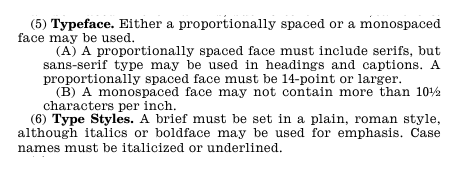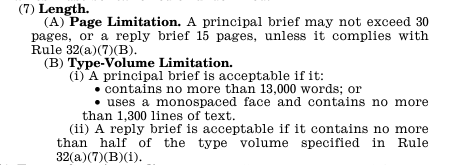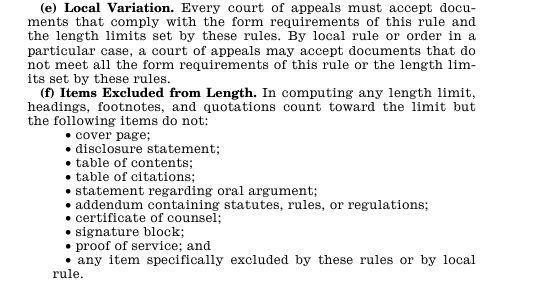Different circuits, different rules
So you’re filing a brief in federal circuit court. You might think that you just need to follow the rules and provisions as established by the Federal Rules of Appellate Procedure (FRAP) and your brief will be compliant.
If only it were that easy.
To avoid the risk having your brief rejected, you’ll also need to follow the specific local rules of the circuit in which you’re filing. While many of the rules are the same, there are several key differences in some of the circuits. Failure to recognize these differences can lead to rejection and hurt your credibility before the court.
In this article, we detail the intricate, specific circuit court rules that you need to know.
Formatting requirements for each federal circuit court: typeface and pagination
The FRAP provides specific guidelines for which typeface to use when submitting a brief and how long a principal brief may be—but, as you’ll see later, some circuits have different ideas about where to start counting the pages, words, or lines of the principal brief.
The FRAP provides these typeface guidelines in Rule 32. Form of Briefs, Appendices, and Other papers:

However, some circuits have more specific rules for exactly which serif typeface is required, and some have very specific rules around pagination. Here are the specific formatting rules for each circuit that you need to be aware of:
First Circuit
- Font size: 14-pt (including footnotes)
- Font: CG Times, Times New Roman
- Pagination: traditional (starting at brief)
Second Circuit
- Font size: 14-pt (including footnotes)
- Font: Century Schoolbook or Times New Roman
- Pagination: traditional (starting at brief)
- Match PDF page labels (required)
- You can use sequential pagination and this is not an issue, but traditional pagination is “preferred” by the court
Third Circuit
- Font size: 14-pt
- Font: Century Schoolbook (doesn’t specify preference)
- Pagination: traditional (starting at brief)
Fourth Circuit
- Font size: 14-pt (including footnotes)
- Font: Times New Roman
- Pagination: traditional (starting at brief)
Fifth Circuit
- Font size: 14-pt (footnotes, 12-pt font or larger)
- Font: Times New Roman
- Pagination: traditional (starting at brief)
Sixth Circuit
- Font size: 14-pt (including footnotes)
- Font: Times New Roman
- Pagination: traditional (starting at brief)
Seventh Circuit
- Font size: 12-pt or larger (footnotes, 11-pt or larger)
- Font: Century Schoolbook
- Pagination: traditional (page 1 begins with jurisdictional statement)
Eighth Circuit
- Font size: 14-pt or larger (footnotes must be same size as text)
- Font: Century Schoolbook
- Pagination: consecutive (starting at brief)
Ninth Circuit
- Font size: 14-pt or larger (including footnotes)
- Font: Century Schoolbook
- Pagination: consecutive (starting at brief)
Tenth Circuit
- Font size: 13-pt or 14-pt (14-pt preferred) (footnotes must be same size as text)
- Font: Century Schoolbook
- Pagination: consecutive (starting at brief)
Eleventh Circuit
- Font size: 14-pt (including footnotes)
- Font: Times New Roman
- Pagination:
- Cover Page – no pagination
- Each page of the CIP must be separately sequentially numbered to indicate the total number of pages comprising the CIP (e.g., C-1 of 3, C-2 of 3, C-3 of 3)
- Statement Regarding Oral Argument, Table of Contents, Table of Authorities, and Jurisdictional statement – lowercase Roman numerals
- Numerical consecutive numbering – starting at Statement of the Issue(s)
Federal Circuit
- Font size: 14-pt (including footnotes)
- Font: Times New Roman
- Pagination: consecutive (starting at brief)
- All page numbers must be centered in bottom margin
- Addendum must share any appendix pagination
DC Circuit
- Font size: 14-pt (including footnotes)
- Font: Times New Roman or Century
- Pagination: consecutive (starting at brief)
Varying required components, length limitations for federal circuit courts
The FRAP provides specific page limitations for a principal brief, as well as word count and type-volume limitations in Rule 32. Form of Briefs, Appendices, and Other papers sub-section 7:

…and it also acknowledges that local rules may differ:

Most circuits follow the FRAP guideline for basic brief structure and required components. However, different circuits have different guidelines for what comprises the principal brief, how sections should be labeled, and where the page, word, or line count should start and end.
Here are the where the local requirements differ from the FRAP guidelines regarding required components and length limitations:
First Circuit
- Statement in support of/against oral argument (optional)
- Page limit, word or line count begins with the Jurisdictional Statement and ends after the Conclusion
- Addendum
- Required
- Must contain the judgment or order appealed from, along with any supporting opinion or memorandum issued by the judge or magistrate judge
- May include 25 pages of other record documents
- Must include an Addendum Table of Contents detailing a description with the docket number and the beginning page number of the addendum where each individual exhibit begins
- Addendum should be paginated separately (bottom center, “ADDM #”)
Second Circuit
- Cover Page
- The docket number in type must be at least one inch in height and centered at the top of the page
- You cannot use et al. on the cover page to indicate parties names – you must list out each individual parties in the caption
- Title of document must be on first page of cover page (i.e., if cover page extends to a second page, “Appellant’s Brief” or “Appellee’s Brief” must still appear on the first page of the cover page, even if the parties names extend to the second page)
- Special Appendix
- If the appendix, exclusive of the orders, opinions, and judgments being appealed, exceeds 300 pages, the parties must file a Special Appendix that conforms to (b), and that contains the (1) orders, opinions, and judgments being appealed, and (2) the text, with appropriate citation, of any significant rule of law, including any constitutional provision, treaty, statute, ordinance, regulation, rule, or sentencing guideline. The Special Appendix may be an addendum at the end of a brief or a separately bound volume designated “Special Appendix.”
- If including a Special Appendix, title the document: Appellant’s Brief and Special Appendix
Third Circuit
- Combined Certifications
- Bar Membership
- Word Count
- Service
- Identical Compliance of Briefs
- Virus Check
- Volume I of separate Appendix to Appellant/Petitioner Brief needs to be attached to end of brief (you still file volume 1 separately)
- Must include:
- Notice of Appeal or Petition for Review
- Order being appealed
- Opinion under review
- Order granting Certificate of Appealability, where applicable
- Must include:
Fourth Circuit
- Request for Oral Argument (optional)
Fifth Circuit
- Follow FRAP guidelines
Sixth Circuit
- Page limit, word or line count begins with the Statement of Jurisdiction and ends after the Conclusion
- Addendum (required)
- Designation of Relevant Lower Court Documents
- Each principal brief must include a designation of relevant documents from the lower court record, which shall be included in an addendum to the brief
- Designation of Relevant Lower Court Documents
References to the Record:
- 6 Cir. R. 28 – a brief must direct the court to the parts of the record it refers to
- In an appeal from the district court, a brief must cite the “Page ID #” shown on the header or footer of the page(s) of the original record being referenced, along with a brief title and the record entry number of the document referenced
- Example: Motion for Summary Judgment, RE 23, Page ID # 120-145
- In an appeal from the district court, a brief must cite the “Page ID #” shown on the header or footer of the page(s) of the original record being referenced, along with a brief title and the record entry number of the document referenced
Seventh Circuit
- Circuit Rule 30(d) Statement
- Required Short Appendix (required for Appellant’s or Petitioner’s main (opening) brief)
- The decision(s) being appealed must always be bound with the appellant’s brief as an attached appendix Certain other required contents of the appendix may also be bound with the brief if the total pages of the appendix do not exceed 50 pages. Cir. R. 30(a), (b).
- Include a Table of Contents for the Short Appendix in the Brief
- Bates Numbering should be “S.A. #”
Eighth Circuit
- Certificate of Compliance
- Must include a statement that the brief and addendum have been scanned for viruses and are virus free
- Addendum (required for Appellants’ briefs)
- Must contain copies of the district court orders from which the appeal is taken, including any magistrate judge reports and recommendations. Additionally, appellant may include up to 15 additional pages of record excerpts.
- Appellee may include an addendum
- The electronic version of the addendum is submitted as a separate document, while the paper version of the addendum should be attached to the paper version of the brief. See 8th Cir. R. 28A(g)(4) and (5).
Ninth Circuit
- Jurisdictional Statement
- Statutory [and Regulatory] Authorities
- Not required – may instead include a sentence like, “All relevant statutory [and/or constitutional and/or regulatory] authorities appear in the Addendum to this brief”
- Addendum
- Under Ninth Circuit Rule 28-2.7, pertinent constitutional provisions, treaties, statutes, ordinances, regulations or rules must be set forth verbatim and with appropriate citation either (1) following the statement of issues presented for review or (2) in an addendum introduced by a table of contents and bound with the brief or separately; in the latter case, a statement must appear referencing the addendum after the statement of issues
Tenth Circuit
- Cover Page: Must include a statement as to whether or not oral argument is requested
- Glossary of Terms
- All briefs containing acronyms or abbreviations not in common use (other than names of parties) must include a Glossary on a page immediately following the Table of Authorities
- Oral Argument Statement
- If oral argument is requested, a statement of the reason(s) why MUST follow the brief’s conclusion
- Required Attachments
- The order(s) under review and the final judgment must be attached to the opening brief
- All attachments to briefs, including those required by Rule 28.2(A), shall be identified and included in the Table of Contents
Eleventh Circuit
- Certificate of Interested Persons and Corporate Disclosure Statement
- Include in CIP Title: No. [Insert 11th Circuit Case Number] [Insert Name of First-Listed Plaintiff or Petitioner v. Name of First-Listed Defendant or Respondent]
Federal Circuit
- Addendum
- Unless an Appellant or Petitioner permissibly binds an appendix with its principal brief, the following materials must be included as an addendum bound with the brief:
- All judgments, orders, agency actions, or other decisions appealed from and any opinions, memoranda, or findings and conclusions supporting them, including any rehearing opinions or orders
- Include a Table of Contents for the Addendum
- Unless an Appellant or Petitioner permissibly binds an appendix with its principal brief, the following materials must be included as an addendum bound with the brief:
References to the Record
- Record citations must be to the appendix
- References in briefs to the appendix must follow the same format as appendix pages
- For referencing consecutive appendix pages, do not drop any repeating leading digits
- For example, a reference to pages 123 through 132 would be Appx123-132, not Appx123-32
DC Circuit
- Cover Page
- Must reference the date of oral argument or reference to submission without oral argument, whichever is applicable, located in capital letters at the top
- Statutes and Regulations
- Such materials must be set forth either in the body of the brief or in an addendum introduced by a table of contents and bound with the brief or separately. Any addendum exceeding 40 pages must be bound separately from the brief.
- If separately bound, a statement must appear in the body of the brief referencing the addendum
- If the addendum is bound with the brief, the addendum must be separated from the body of the brief (and from any other addendum) by a distinctly colored separation page
Use technology to avoid brief formatting errors
As you can see, there are many, many intricate rules to follow in order to accurately prepare a brief for a federal circuit court of appeals—it’s not as easy as just following the FRAP. In fact, we recently published a list of 48 ways to get your brief rejected in federal court.
Accurately preparing your brief for federal court can get pretty complex and time-consuming, particularly if you don’t file in that circuit very often. Using an automated brief formatting platform, such as TypeLaw, which has all the court-specific local rules built in, can help you quickly prepare a compliant brief for the federal circuit courts of appeals, or any other US court.